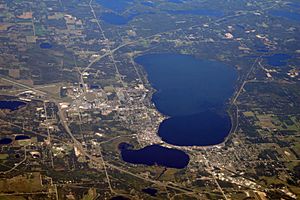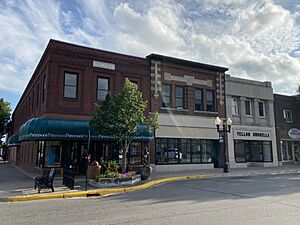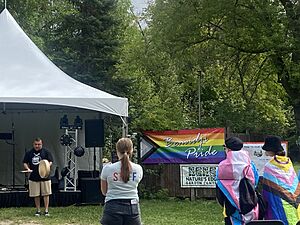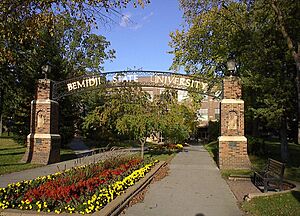Bemidji, Minnesota facts for kids
Quick facts for kids
Bemidji, Minnesota
|
||
|---|---|---|
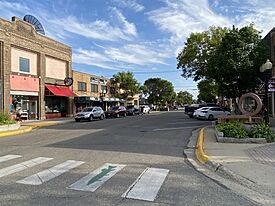
Beltrami Avenue
|
||
|
||
| Motto(s):
"The First City on the Mississippi"
|
||
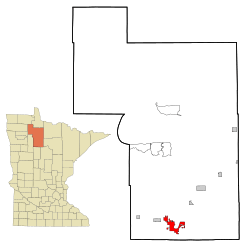
|
||
| Country | United States | |
| State | Minnesota | |
| County | Beltrami | |
| Founded | 1888 | |
| Incorporated | May 20, 1896 | |
| Area | ||
| • City | 22.335 sq mi (57.847 km2) | |
| • Land | 17.440 sq mi (45.169 km2) | |
| • Water | 4.895 sq mi (12.679 km2) 21.90% | |
| Elevation | 1,368 ft (417 m) | |
| Population
(2020)
|
||
| • City | 14,574 | |
| • Estimate
(2022)
|
15,946 | |
| • Density | 914.0/sq mi (353.0/km2) | |
| • Urban | 14,849 | |
| • Metro | 46,718 (US: 246th) | |
| Time zone | UTC−6 (Central (CST)) | |
| • Summer (DST) | UTC−5 (CDT) | |
| ZIP Code |
56601
|
|
| Area code(s) | 218 | |
| FIPS code | 27-05068 | |
| GNIS feature ID | 0655325 | |
| Sales tax | 7.875% | |
Bemidji (pronounced bə-MIJ-ee) is a city in northern Minnesota, United States. It is the main city of Beltrami County. In 2020, about 14,574 people lived there. By 2022, the population was estimated to be around 15,946. This makes Bemidji the biggest business center between Grand Forks, North Dakota and Duluth.
Bemidji is important for three Indian reservations nearby: the Red Lake Indian Reservation, White Earth Indian Reservation, and Leech Lake Indian Reservation. Many Native American services are located here. The city sits on the southwest shore of Lake Bemidji. This lake is the northernmost point where the Mississippi River begins its long journey. Because of this, Bemidji is called "The First City on the Mississippi." The city also calls itself the "curling capital" of the U.S. It is also said to be the birthplace of the famous lumberjack, Paul Bunyan.
Contents
- What's in a Name? The Story of Bemidji
- A Look Back: Bemidji's History
- Fun Things to Do: Parks and Recreation
- Where is Bemidji? Geography
- Bemidji's Weather: Climate
- Who Lives Here? Demographics
- How People Make a Living: Economy
- Culture and Fun in Bemidji
- Sports in Bemidji
- Learning in Bemidji: Education
- A Center for the Region
- News and Media
- Getting Around: Infrastructure
- Famous People from Bemidji
- Images for kids
- See also
What's in a Name? The Story of Bemidji
The name Bemidji comes from the Ojibwe words Buh-mid-ji-ga-maug. This means "a lake with crossing waters." It describes how the Mississippi River flows right through Lake Bemidji.
An Ojibwe leader named Shay-now-ish-kung moved to the area in 1882. He was the first person to settle there permanently. He told early white settlers the name of the lake. However, they thought he was saying his own name was Bemidji. So, they started calling him Chief Bemidji.
Sometimes, in Ojibwe, Bemidji is called Wabigamaang. This means "at the lake channel/narrows." This is because part of the city is on the narrow area between Lake Bemidji and Lake Irving.
A Look Back: Bemidji's History
Beltrami County was created on February 28, 1866. Bemidji Township was surveyed by European Americans in 1874. It became an organized township in 1896.
Before the 1880s, about 50 Leech Lake Indians lived along the south shore of the lake. They called the lake Bemidjigumaug. This meant "river or route flowing crosswise." Freeman and Besty Doud were Bemidji's first homesteaders. They claimed land west of what is now Diamond Point. The Porter Nye family soon followed them.
John Steidl had a sawmill on the east side of the Mississippi River. It was near Carson's Trading Post. The Remore Hotel and Carl Carlson's blacksmith shop were on the west side. Bemidji officially became a city on May 20, 1896. By then, there were three publishing companies. These included The Bemidji Pioneer. William Bartleson started a service to carry mail between Bemidji and Park Rapids.
By 1898, railroads reached Bemidji. This brought even more businesses to the area. By 1900, the city of Bemidji had grown to 2,000 people.
Big investors like Thomas Barlow Walker bought lots of timber in 1874. This was because beaver pelts were becoming scarce. Logging became a major industry. Lumberjacks worked in logging camps during the winter. Sawmills processed the wood in the summer.
In the early 1900s, there were droughts and forest fires. A sawmill burned down in 1914, which was a big problem for businesses. It was later rebuilt. During the Great Depression in the 1930s, Bemidji's businesses did well. They provided food and services for government programs like the Civilian Conservation Corps. After World War II, the lumber business grew again as many people needed new homes.
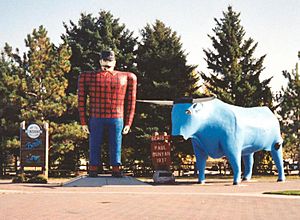
The story that the legendary figure Paul Bunyan came from the Northwoods was created by Art Lee. Tales about Paul Bunyan and Babe the Blue Ox led to statues of them being built in the 1930s. The statues are very popular. They are said to be the second most photographed statues in America. Only Mount Rushmore is photographed more.
The Paul Bunyan statue was built during the Great Depression. It was meant to attract tourists. It was shown to the public on January 15, 1937. This started a Winter Carnival that brought over 10,000 visitors.
Today, Bemidji is an important center for education, government, trade, and health care in northern Minnesota. The wood industry is still a big part of the local economy. Companies like Georgia-Pacific have plants that use wood from trees once thought of as waste.
Fun Things to Do: Parks and Recreation
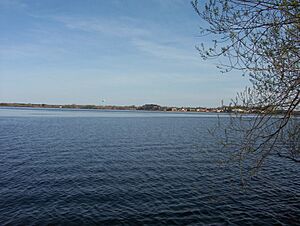
Bemidji is close to many beautiful natural areas. These include Chippewa National Forest, Itasca State Park, Lake Bemidji State Park, and Big Bog State Recreation Area. There are over 400 lakes within 25 miles (40 km) of the city. You can also find 500 miles (800 km) of snowmobile trails and 100 miles (160 km) of cross-country ski trails.
The Paul Bunyan State Trail starts near Bemidji. It is great for walking, biking, snowmobiling, and cross-country skiing. There is also a 17-mile (27 km) bike trail around Lake Bemidji. Each year, an event is held where families can bike around the lake.
Art in the Park is a popular summer event. It features over 100 artists, food, and live entertainment. You can find items made from wood and ceramics, clothing, jewelry, and more. About 4,000 people attend this festival every year. It is now called the Watermark Art Festival.
Every August, teams compete in exciting Dragon Boat races. This event also has food, kids' activities, and music. Dragon boat racing has become a very popular water sport.
Bemidji Polar Days, also known as Winterfest, is a week-long winter festival. It includes fun activities like a polar plunge, sled derby, broomball, and a 5k walk/run. There are also curling and pond hockey games.
The Paul Bunyan Triathlon takes place in August. The Minnesota Finlandia Ski Marathon is also held in Bemidji.
Where is Bemidji? Geography
Bemidji covers about 22.3 square miles (57.8 sq km). About 17.4 square miles (45.2 sq km) is land, and 4.9 square miles (12.7 sq km) is water.
Major roads in the city include U.S. Route 2 and U.S. Route 71. Other state highways are also nearby.
The biggest earthquake recorded near Bemidji happened on September 3, 1917. It was felt across northern Minnesota. It had a strength of 4.4 on the Richter magnitude scale. A smaller quake happened closer to Bemidji in 1982.
Bemidji's Weather: Climate
Bemidji has a humid continental climate. This means it has short, warm summers and long, cold winters. The average yearly temperature is about 38.6 degrees Fahrenheit (3.7 degrees Celsius).
January is the coldest month. The average high is 16 degrees F (-9 C), and the average low is -5 degrees F (-21 C). July is the warmest month. The average high is 77 degrees F (25 C), and the average low is 57 degrees F (14 C).
Bemidji gets about 46.7 inches (119 cm) of snow each year. It also gets about 26.6 inches (68 cm) of rain. Lake Bemidji usually freezes over around November 26 and the ice melts around April 26.
Who Lives Here? Demographics
| Historical population | |||
|---|---|---|---|
| Census | Pop. | %± | |
| 1900 | 2,183 | — | |
| 1910 | 5,099 | 133.6% | |
| 1920 | 7,086 | 39.0% | |
| 1930 | 7,202 | 1.6% | |
| 1940 | 9,427 | 30.9% | |
| 1950 | 10,001 | 6.1% | |
| 1960 | 9,958 | −0.4% | |
| 1970 | 11,490 | 15.4% | |
| 1980 | 10,949 | −4.7% | |
| 1990 | 11,245 | 2.7% | |
| 2000 | 11,917 | 6.0% | |
| 2010 | 13,431 | 12.7% | |
| 2020 | 14,574 | 8.5% | |
| 2022 (est.) | 15,946 | 18.7% | |
| U.S. Decennial Census 2020 Census |
|||
In 2020, Bemidji had 14,574 people living in 6,014 households. Most residents (72.1%) were White. About 13.9% were Native American, and 2.7% were Black or African American. About 4.0% of the population was Hispanic or Latino.
About 20.1% of residents were under 18 years old. About 15.9% were 65 years or older. The average household had 2.18 people.
How People Make a Living: Economy
In 2022, the average household income in Bemidji was $65,939.
Top Employers in Bemidji
The biggest employers in Bemidji are:
- Sanford Health (2,200 employees)
- Bemidji Public Schools (975 employees)
- Bemidji State University (555 employees)
- Beltrami County (325 employees)
Main Industries in Bemidji
The top industries in Bemidji include:
- Education, health care, and social help
- Retail trade (stores)
- Arts, entertainment, recreation, and food services
- Public administration (government jobs)
- Construction
- Manufacturing
Culture and Fun in Bemidji
The Concordia Language Villages are located near Bemidji. These villages help people learn different languages. They have groups that meet weekly to practice languages like French, Chinese, and Spanish. In 2018, the Korean Language Village received a large grant.
The Red Lake Ojibwe Nation has praised Bemidji for using Ojibwe language signs in businesses.
During the summer, the Paul Bunyan Playhouse puts on live theater shows. The Bemidji Community Theatre also performs there at other times. Bemidji is home to the Bemidji Symphony Orchestra (BSO). It started in 1938 and is now an independent arts group.
The statues of Paul Bunyan and Babe the Blue Ox are very popular. Tourists love to take pictures with them. They are next to the Bemidji Tourist Information Center. Here, visitors can learn about local activities and attractions. The center also has items related to the Paul Bunyan legend. There is a giant guest book where travelers can sign their names. An old fireplace there was built with 900 stones. These stones came from every U.S. state, most Canadian provinces, and Minnesota national parks.
Sports in Bemidji
Bemidji is well-known for hockey. The Bemidji State University hockey team was very strong in the 1980s and 90s. They won five titles as a Division II team. They became a Division I team in 1999.
The city is also famous for curling. Both men's and women's curling teams from Bemidji have represented the United States. They competed in the 2005 World Curling Championship and the 2006 Winter Olympics in Italy. Pete Fenson, who won a bronze medal in curling at the 2006 Olympics, is from Bemidji. Natalie Nicholson, who was on the U.S. women's team at the 2010 Winter Olympics, is also from Bemidji.
The Sanford Center opened in 2010. It is the home of the Bemidji State University hockey teams. From 2014 to 2015, it was also home to the city's first professional sports team, the Bemidji Axemen (an indoor football team).
In January 2019, Bemidji hosted Hockey Day Minnesota. This was a three-day event shown on TV. High school and university hockey teams played on outdoor rinks. Even the Minnesota Wild team played there.
In 2013, the first Bemidji Blue Ox Marathon was held. This race takes place in October. It includes different races like a 5K, 10K, half-marathon, and a 26K race around Lake Bemidji.
Learning in Bemidji: Education
Bemidji is home to several colleges:
- Bemidji State University
- Northwest Technical College
- Oak Hills Christian College
Public schools in Bemidji are part of Independent School District 31. This includes eight elementary schools, one middle school, and one high school. There are also several charter schools and four private schools in the area.
A Center for the Region
Bemidji is a central place for shopping, arts, entertainment, education, health services, and government for many people. The Bemidji area serves parts of several counties in Minnesota. It also includes parts of the White Earth Indian Reservation, Leech Lake Indian Reservation, and the Sovereign Nation of Red Lake.
News and Media
Newspapers
The Bemidji Pioneer is the local newspaper. It is published twice a week. It started as a weekly paper in 1896.
TV Stations
Most TV stations in Bemidji show programs from the Twin Cities.
| Channel | Callsign | Affiliation | Branding | Subchannels | Owner | |
|---|---|---|---|---|---|---|
| (Virtual) | Channel | Programming | ||||
| 9.1 | KAWE | PBS | Lakeland PBS | 9.2 9.3 9.4 9.5 9.6 |
First Nations Experience PBS Kids Create PBS Encore Minnesota Channel |
Northern Minnesota Public Television, Inc. |
| 11.1 | K20MN-D (KRII Translator) |
NBC | KBJR 6 | 11.2 11.3 |
CBS H&I/MyNetworkTV |
Red Lake Band of Chippewa Indians |
| 12.1 | KCCW (WCCO-TV Satellite) |
CBS | WCCO 4 | 12.2 | Start TV | CBS Corporation |
| 13.1 | K24MM-D (WIRT Translator) |
ABC | WCCO 4 | 13.2 13.3 |
MeTV Ion Television |
Red Lake Band of Chippewa Indians |
| 19.1 | K32MF-D (WGN-TV Translator) |
Independent-> The CW
eff. (9/1/2024) |
WGN 9 | Red Lake Band of Chippewa Indians | ||
| 22.1 | KAWB | PBS | Lakeland PBS | 22.2 22.3 22.4 22.5 22.6 |
First Nations Experience PBS Kids Create PBS Encore Minnesota Channel |
Northern Minnesota Public Television, Inc. |
| 26.1 | KFTC (WFTC Satellite) |
FOX | FOX 9 | 26.2 26.3 |
FOX9+ Movies! |
Fox Television Stations, Inc. |
Radio Stations
Bemidji has many radio stations, playing different types of music and news.
FM Radio Stations
| FM radio stations | ||||
|---|---|---|---|---|
| Frequency | Call sign | Name | Format | Owner |
| 88.5 FM | KCRB | Classical MPR | Classical music | Minnesota Public Radio |
| 89.7 FM | KBSB | FM 90 | College radio/Top 40 (CHR) | Bemidji State University |
| 90.5 FM | KBXE | Northern Community Radio | Music, local news & arts, National Public Radio | Northern Community Radio |
| 91.3 FM | KNBJ | MPR News | NPR | Minnesota Public Radio |
| 92.1 FM | WMIS-FM | The River 92.1 | Adult Hits | Paskvan Media |
| 92.7 FM | W224AB (KBHW Translator) |
Psalm 99:5 | Christian | Oak Hills Fellowship |
| 93.5 FM | K228EW (KOPJ Translator) |
LifeTalk Radio | Christian | Seventh-day Adventist Church |
| 94.3 FM | W232DS (KPMI Translator) |
The Legends | Classic Country | Paskvan Media |
| 94.9 FM | K235BP (KBUN (AM) Translator) |
The Bun | Sports | Paul Bunyan Broadcasting |
| 95.5 FM | KKZY | KZY 95.5 | Adult contemporary | Paul Bunyan Broadcasting |
| 96.7 FM | KKCQ-FM | Q Country | Country | R&J Broadcasting, Inc |
| 98.3 FM | WBJI-FM | Babe Country 98.3 | Country | RP Broadcasting |
| 99.1 FM | KLLZ-FM | Z99 | Classic rock | Paul Bunyan Broadcasting |
| 101.1 FM | KBHP | KB101 | Country | Paul Bunyan Broadcasting |
| 102.5 FM | KKWB | Coyote 102.5 | Country | De La Hunt Broadcasting |
| 103.1 FM | K276EP (KKWB Translator) |
Coyote 102.5 | Country | De La Hunt Broadcasting |
| 103.7 FM | KKBJ-FM | Mix 103.7 | Hot AC | RP Broadcasting |
| 104.5 FM | KBUN-FM | Sports | Paul Bunyan Broadcasting | |
| 105.3 FM | K287AD (KOJB Translator) |
Community radio | Leech Lake Band of Ojibwe | |
| 107.1 FM | KKEQ | Your Q FM | Contemporary Christian music | Pine to Prairie Broadcasting |
AM Radio Stations
| AM radio stations | ||||
|---|---|---|---|---|
| Frequency | Call sign | Name | Format | Owner |
| 820 AM | WBKK | AM 820 | Catholic Talk | Real Presence Radio |
| 1300 AM | KPMI | County Legends | Classic Country | Paskvan Media |
| 1360 AM | KKBJ | Talkradio 1360 | News/Talk | RP Broadcasting |
| 1450 AM | KBUN | The Bun | Sports (KFAN/ESPN programming) |
Paul Bunyan Broadcasting |
Magazines
- inBemidji is a quarterly magazine about life in the Bemidji area.
- Northwoods Woman was a magazine published from 2008 to 2013. It featured articles about women in northern Minnesota.
Getting Around: Infrastructure
Major Highways
These are the main roads in the Bemidji area:
Air Travel
Bemidji is served by the Bemidji Regional Airport. You can fly with airlines like Delta Connection and Sun Country Airlines. Bemidji Airlines is based here and also flies cargo. Corporate Air flies cargo for FedEx Express.
Famous People from Bemidji
- Rita Albrecht, former mayor of Bemidji
- Dave Casper, football player
- Pete Fenson, Olympic curling medalist
- Bryan Hickerson, baseball player
- Joe Motzko, hockey player
- Mimi Parker, drummer and singer for the band Low
- Jane Russell, actress
- Gary Sargent, ice hockey player
- Will Weaver, author and professor
Images for kids
See also
 In Spanish: Bemidji (Minnesota) para niños
In Spanish: Bemidji (Minnesota) para niños




